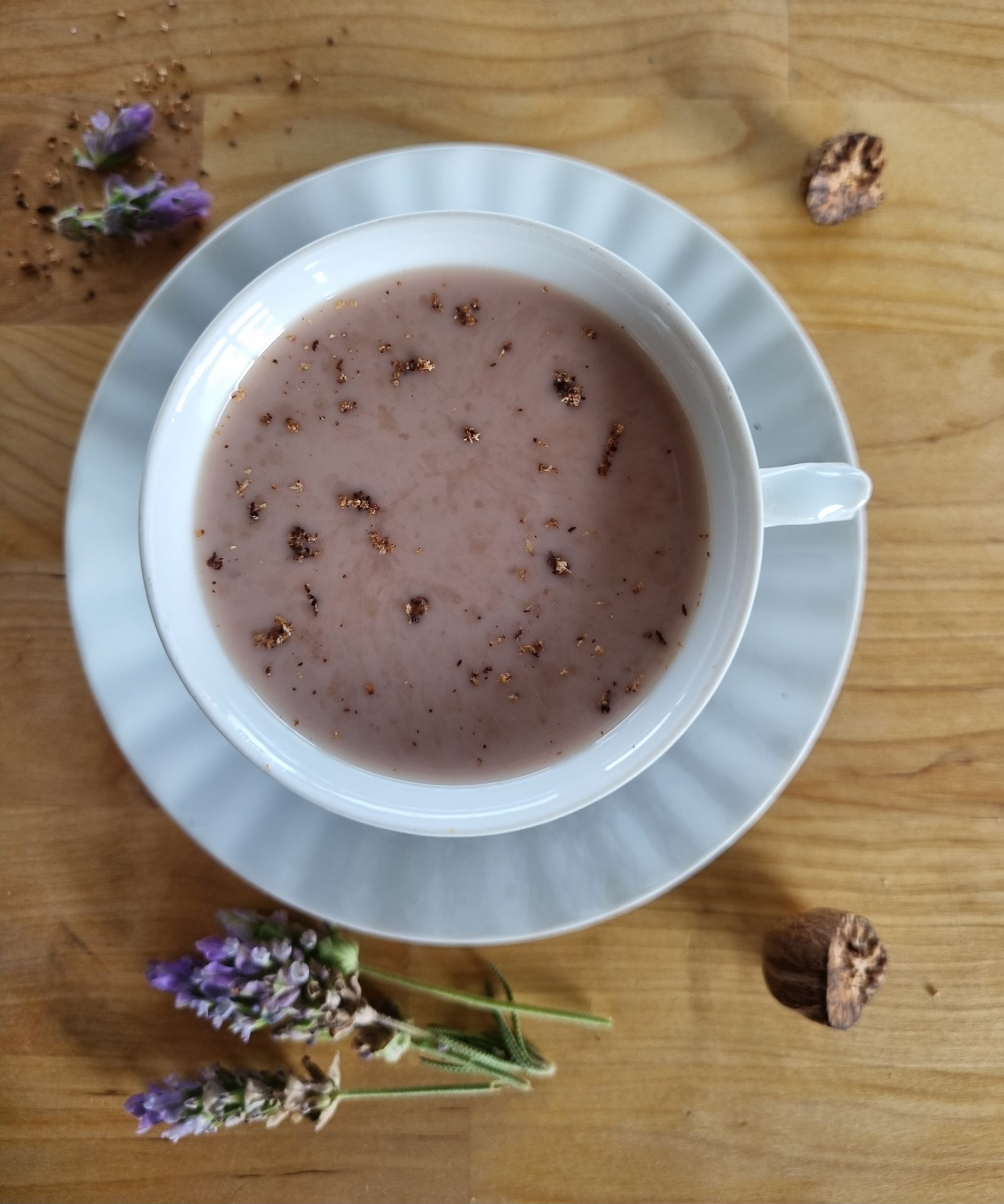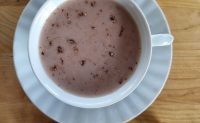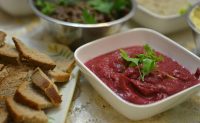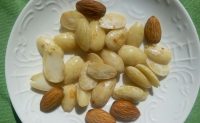Pink Moon Milk
Eyal Shpringer

Pink Milk is a calming and sleep-promoting beverage based on concepts and ingredients originating in Ayurveda, the Indian medicine. Pink milk is suitable when you feel fragile, depleted, weak, and restless. Pink milk is especially valuable for restoring sleep and mental resilience in a harsh or eroding reality.
Pink milk usually comprises three main ingredients: warm milk (animal or plant-based), cherry concentrate or juice, and powdered root of Withania somnifera, also known as “Ashwagandha.” There are variations to the basic recipe containing additional ingredients that contribute to the calming effect.
Most of the beverages’s ingredients can be found in supermarkets or natural food stores.
Ingredients for one large serving that can be shared:
1/2 teaspoon Ashwagandha root powder – finely ground – available in most natural food stores
1 cup cow’s milk, goat’s milk, or high-quality almond milk
2/3 cup cherry juice (can also be made from diluted cherry concentrate) – best to buy in natural food stores
One teaspoon of sweeteners such as molasses, silane (date honey), or a kind of sugar called jaggery
Pink Milk Preparation
Pour the milk into a small pot and mix in the ashwagandha powder. Heat to just before boiling.
Add the cherry juice and heat again just before boiling.
Remove from heat, and when the milk has cooled down a little, drink the beverage, preferably around 6 p.m. when the quality of Vata is still dominant.
Additional Options:
Using other kinds of milk: Cow’s or almond milk is most suitable for inducing sleep and calm. If you don’t get along with or can not find these types of milk, you can also use good quality oat milk, although its calming effect is weaker.
Adding a pinch of nutmeg: Nutmeg has a warming, stabilizing, digestion-supporting, dampness-reducing, and mind-protecting effect that assists with sleep. It is especially suitable for dry, fragile Vata patients with sensitive digestion who experience vulnerability and sleep difficulties.
Adding a few lavender flowers to the hot milk before serving: Unlike nutmeg, lavender flowers are lighter and less warm. They are suitable for patients whose sleep difficulties and tension experienced are related to anger, intensity, and urge to act even when one is ineffective. It is advisable not to mix nutmeg and lavender in the same beverages as their effects are not harmonious.
Remarks:
*Use as little sweetener as possible. Using high amounts of sweeteners can cause blood sugar instability and, as a result, lead to sugar imbalances that can impair the ability to relax and maintain sleep.
**Although the recipe is based on Ayurvedic ideas and ingredients, it should be noted that Ayurveda does not favor mixing animal milk with fruit products. Therefore, for those who want to adher to the spirit of Ayurveda and avoid accumulation of AMA (bodily waste), it is advisable to use good quality almond milk.
***Even if some of the ingredients are not available for you now, you can still use those available to you. Each main ingredient (ashwagandha, milk, cherry juice, nutmeg, lavender) has a relaxing effect that supports sleep. Without the other ingredients, you can happily make warm milk with nutmeg ashwagandha or raspberry concentrate. However, the whole combination of ingredients will likely give better results.
Pink milk beverage from a traditional medicine perspective:
Pink milk is a beverage that calms Vata’s quality associated with dryness, coldness, fragility, and the feeling that our connection to life is threatened or unstable. The quality of most of the recipe’s ingredients is heavy, moist, nourishing, and warming. Looking at the ingredients, we can see how each has a unique effect that contributes to the drink’s influence:
Animal based milk: Animal based milk is considered in Ayurveda as a sweet and moisturizing, nourishing and supporting the lymph, the nervous system, and reproductive tissues. Milk is used as a vehicle for medicinal herbs, helps them reaching the lungs and heart area and helps nourish, and calm these organs. Animal milk contains the amino acid tryptophan, which assists in producing the neurotransmitter serotonin and the hormone melatonin, aiding relaxation and sleep. In addition, animal milk contains the milk-protein casein, which tends to break down into casomorphins – molecules that act similarly to morphine and encourage calm and sleep.
Almond milk: Has a sweet-bitter taste that helps nourish and direct the prana (vitality) downward while calming the heart and mind. The almond nourishes various tissues, including brain and heart. Its effect is similar to many of its family members (cherry, apricot, peach). These fruits of the almond family contain a single pit embedded in the fruit “heart,” pointing at their ability to support and treat the heart. Almonds contain various minerals, especially calcium and magnesium, that assist with relaxation. In addition, almonds contain small amounts of the sleep hormone melatonin.
Cherry juice: Raspberries are red and sour with a warming quality. These fruits are traditionally associated with the heart. Their tart taste with its inward direction, representing the mind’s ability to withdraw and allow calm and sleep. Cherries much like almonds contain melatonin while some preliminary interventional studies indicate the sleep-promoting effect of raspberry juice.
Ashwagandha root: The ashwagandha root is a highly-valued plant that is becoming familiar and widlly accepeted among the general population. It is an adaptogenic herb that assists the nervous and hormonal systems coping with all kinds of stressors and supports the quality of sleep. The plant supports many tissues, including the muscles, heart, nervous system, and the adrenal glands. Ashwagandha supports a strong and stable body and mind and helps us cope with life’s difficulties.
From the perspective of lymph and blood theory based of the “seven tissue” Ayurvedic model, it can be said that the milk based recipe emphasizes the lymphatic system, representing a connection to early maternal stages of human existence. Additionally the sour cherries represent the restraint of the fiery, active quality of the blood, which chould be calmed down in order to allow relaxation and sleep.
The recipe is especially suitable for thin, fragile, and active patients who need to reacquire the art of slowing down, and recovery. The recipe is less ideal for patients with “excess” conditions manifesting in dampness or heat: obesity, skin diseases, tendency to redness, and oily skin.
Eyal Shpringer, A Chinese medicine practitioner and a clinical herbalist specializing in Chinese nutrition and traditional nutritional approaches. Eyal holds a master’s degree in research of East Asian medicines. Since 2007 he has been teaching a postgraduate training program in Chinese and oriental nutrition according to the TEF method and other courses and workshops for practitioners. Eyal co-authored the bestselling book Cooking for Life: A Traditional Nutrition Cookbook for Cancer Patients (Hebrew).
Did you find the recipe interesting? Do you want to continue studying with me?
You are invited to join me on my Instagram page and the Traditional Nutrition and Medicine Facebook group.


